Preliminary Biological Evaluation of Novel 99mTc-Cys-Annexin A5 as a Apoptosis Imaging Agent
Abstract
:1. Introduction
2. Results and Discussion
2.1. Radiolabeling
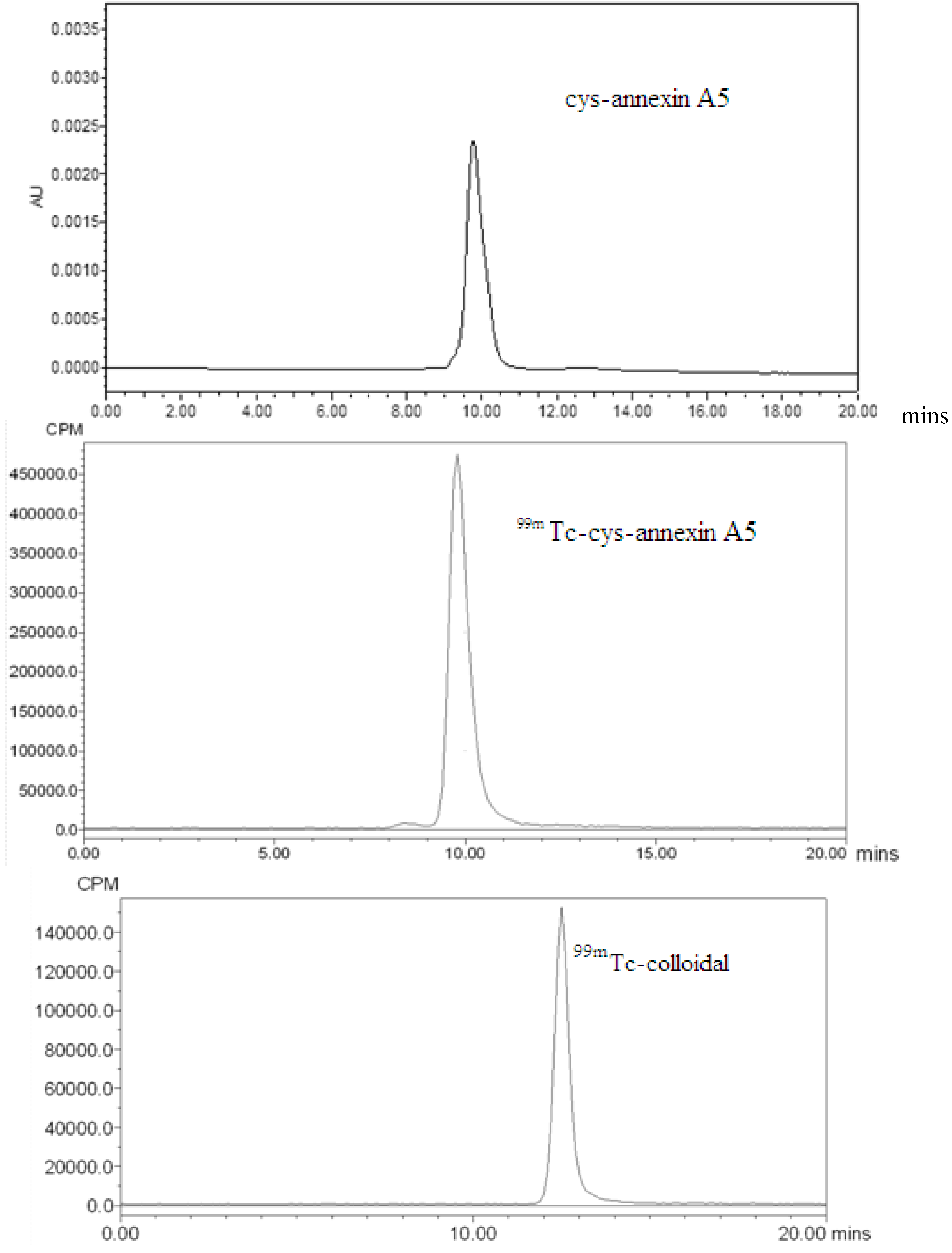

2.2. Blood Kinetics Studies
| Parameters | 99mTc-cys-annexin v |
|---|---|
| K12 (min−1) | 0.079 |
| K21 (min−1) | 0.02 |
| Ke (min−1) | 0.029 |
| CL (%ID/g/min) | 0.084 |
| T1/2α (min) | 5.619 |
| T1/2β (min) | 129.465 |
| AUC (%ID/g*min) | 238.123 |
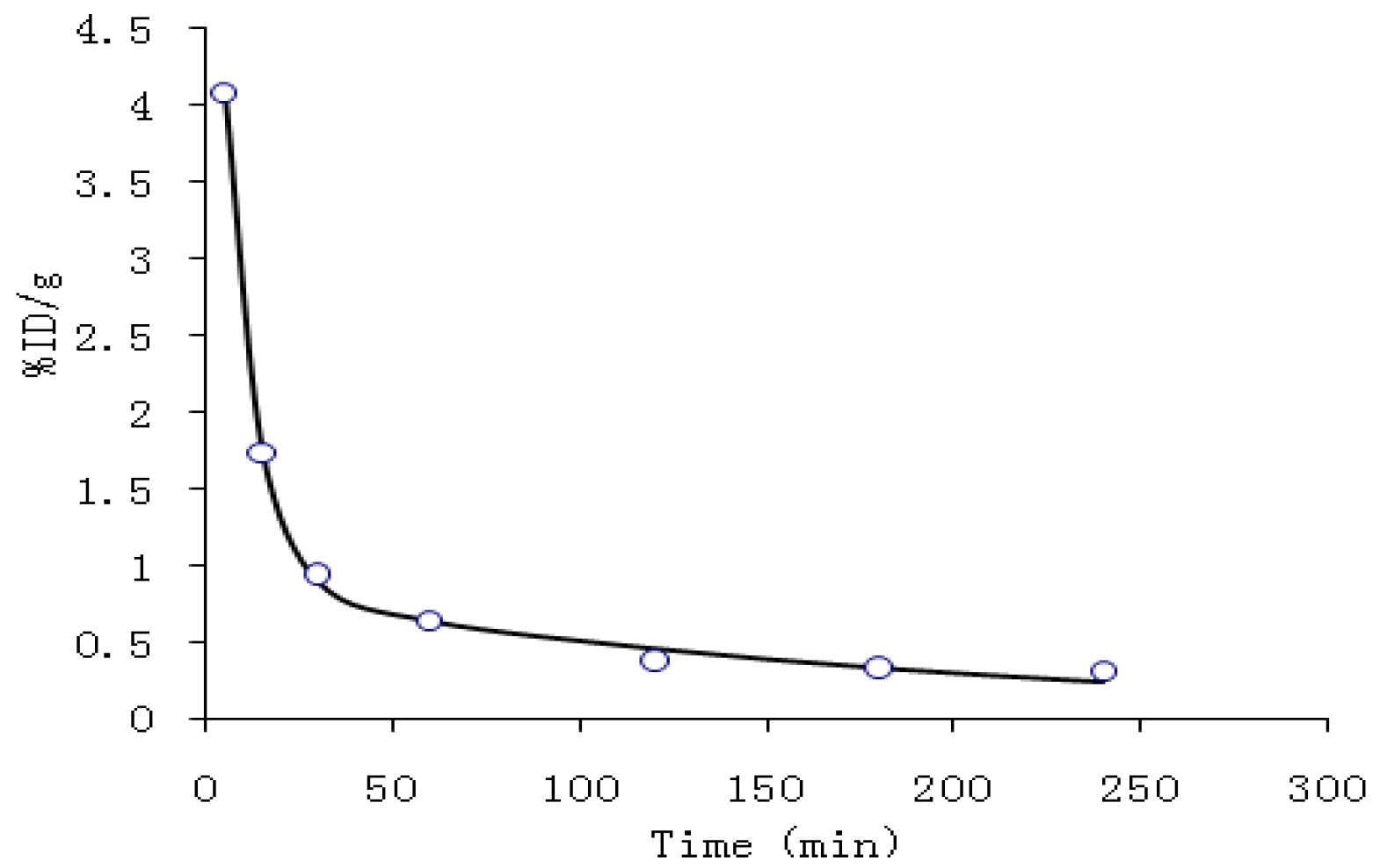
2.3. Biodistribution Studies
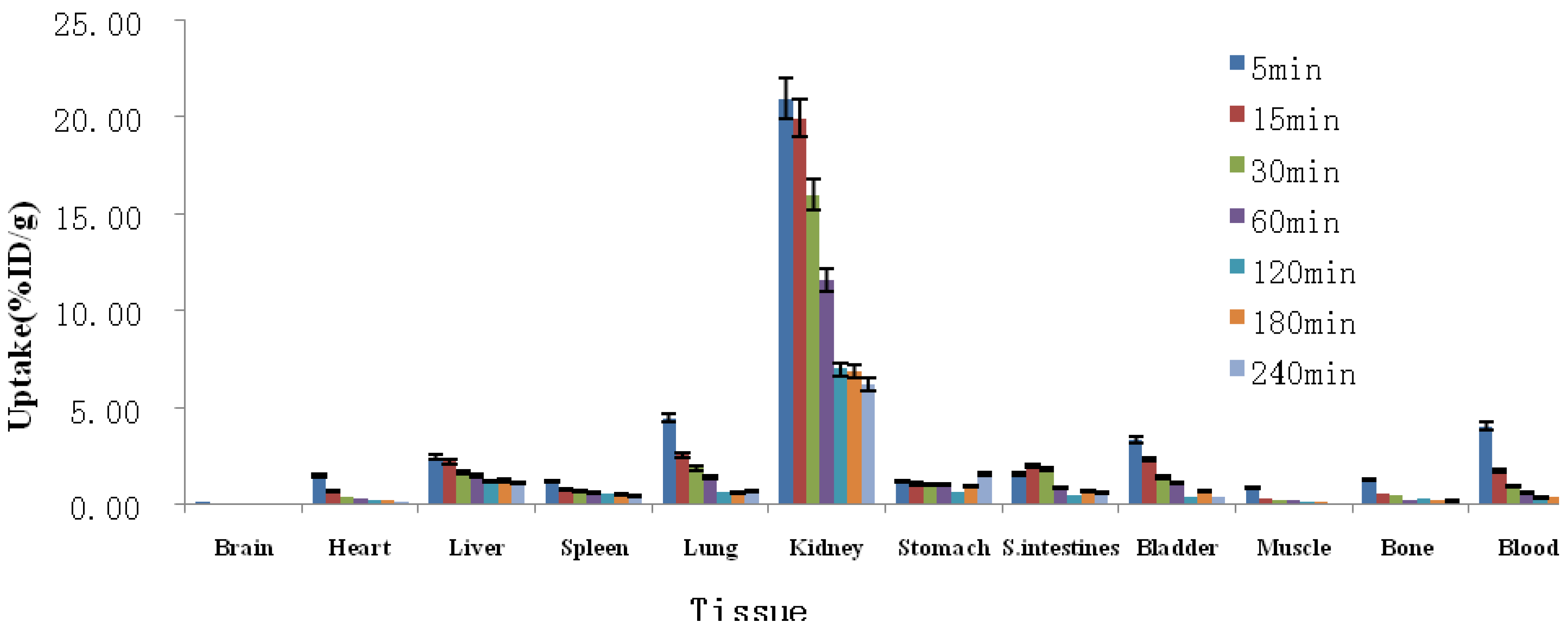
| Tissue | %ID/g(60min) | |
|---|---|---|
| 99mTc-cys-annexin A5 | 99mTc-HYNIC-annexin A5 [7] | |
| Heart | 0.26 ± 0.03 | 1.20 ± 0.25 |
| Liver | 1.50 ± 0.15 | 6.65 ± 1.02 |
| Spleen | 0.60 ± 0.03 | 6.52 ± 1.56 |
| Lung | 1.42 ± 0.30 | 2.56 ± 0.68 |
| Kidney | 11.61 ± 1.12 | 114 ± 17.1 |
| Stomach | 1.07 ± 0.44 | 1.33 ± 0.19 |
| S. intestines | 0.89 ± 0.16 | 0.97 ± 0.09 |
| Muscle | 0.24 ± 0.14 | 0.37 ± 0.08 |
| Bone | 0.25 ± 0.03 | 0.78 ± 0.14 |
| Blood | 0.64 ± 0.15 | 1.77 ± 0.31 |
2.4. Imaging of Rat Model of Apoptosis
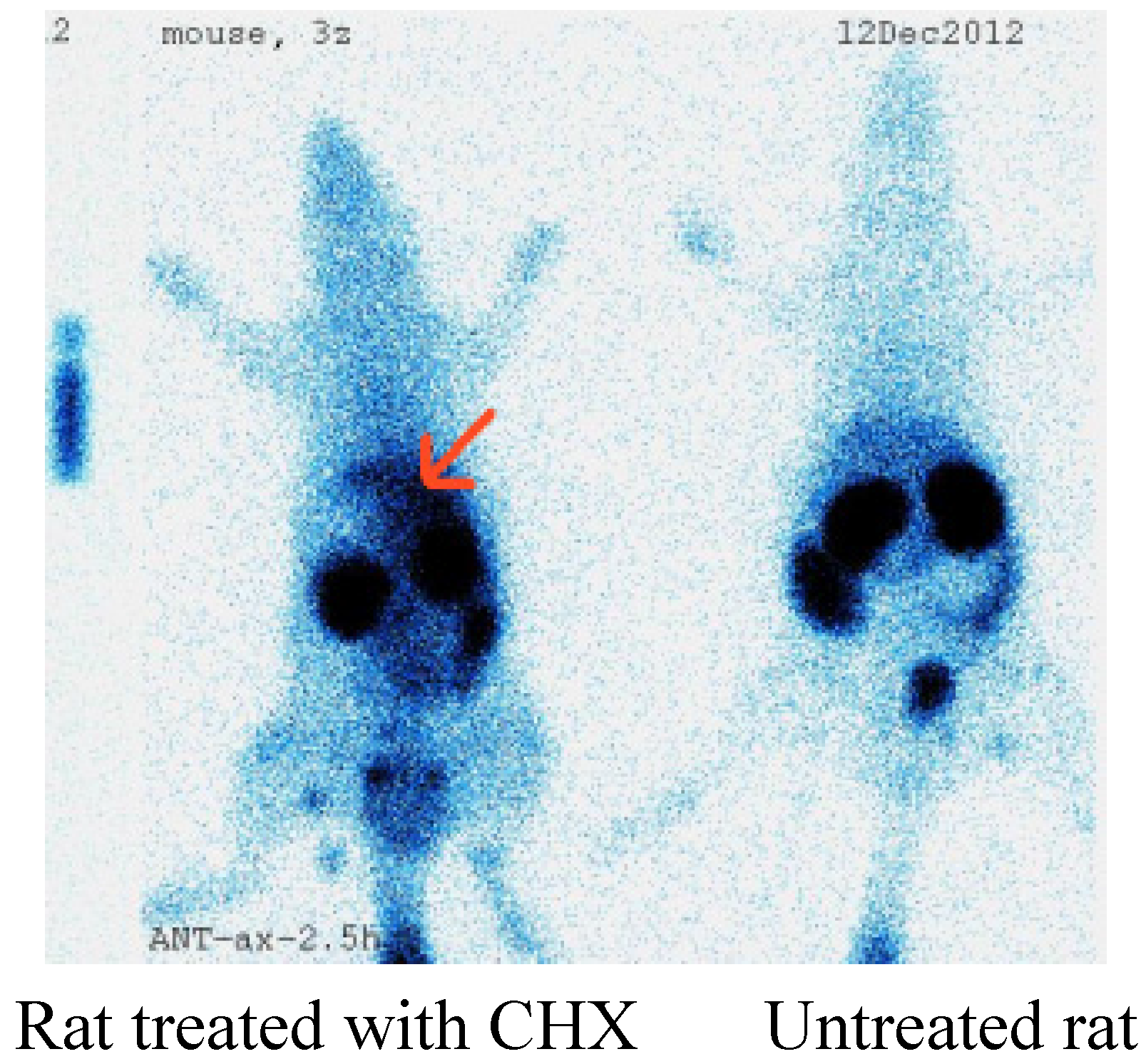
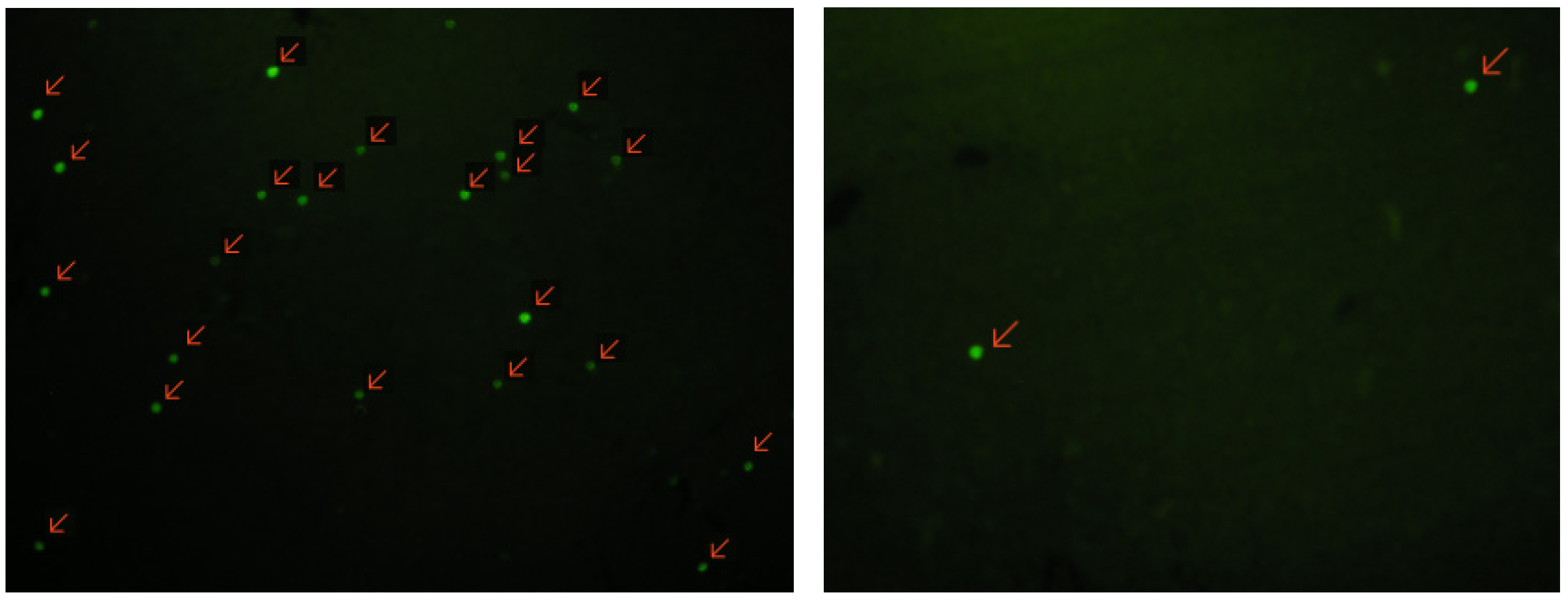
2.5. Toxicity Test
3. Experimental
3.1. General
3.2. Radiochemical Synthesis of 99mTc-cys-Annexin A5
3.3. Quality Control of 99mTc-cys-Annexin A5
3.4. Biodistribution in Normal Mice of 99mTc-cys-Annexin A5
3.5. Animal Model of Apoptosis
3.6. TUNEL Staining
4. Conclusions
Acknowledgments
Conflicts of Interest
References
- Fink, S.L.; Cookson, B.T. Apoptosis, pyroptosis, and necrosis: Mechanistic description of dead and dying eukaryotic cells. Infect. Immun. 2005, 73, 1907–1916. [Google Scholar] [CrossRef]
- Hofstra, L.; Liem, I.H.; Dumont, E.A.; Boersma, H.H.; van Heerde, W.L.; Doevendans, P.A.; DeMuinck, E.; Wellens, H.J.J.; Kemerink, G.J.; Reutelingsperger, C.P.M.; et al. Visualisation of cell death in vivo in patients with acute myocardial infarction. Lancet 2000, 356, 209–212. [Google Scholar] [CrossRef]
- Thiagarajan, P.; Tait, J.F. Binding of Annexin-V Placental Anticoagulant ProteinI To Platelets—Evidence For Phosphatidylserine Exposure In The Procoagulant Response Of Activated Platelets. J. Biol. Chem. 1990, 265, 17420–17423. [Google Scholar]
- Tait, J.F.; Gibson, D.; Fujikawa, K. Phospholipid Binding-Properties Of Human Placental Anticoagulant Protein-I, A Member Of the Lipocortin Family. J. Biol. Chem. 1989, 264, 7944–7949. [Google Scholar]
- Gerke, V.; Moss, S.E. Annexins: From structure to function. Physiol. Rev. 2002, 82, 331–371. [Google Scholar]
- Koopman, G.; Reutelingsperger, C.P.M.; Kuijten, G.A.M.; Keehnen, R.M.J.; Pals, S.T.; Vanoers, M.H.J. Annexin-V For Flow Cytometric Detection Of Phosphatidylserine Expression On B-cells Undergoing Apoptosis. Blood 1994, 84, 1415–1420. [Google Scholar]
- Kemerink, G.J.; Boersma, H.H.; Thimister, P.W.; Hofstra, L.; Liem, I.H.; Pakbiers, M.T.; Janssen, D.; Reutelingsperger, C.P.; Heidendal, G.A. Biodistribution and dosimetry of 99mTc-BTAP-annexin-V in humans. Eur. J. Nucl. Med. 2001, 28, 1373–1378. [Google Scholar] [CrossRef]
- Vanderheyden, J.L.; Liu, G.; He, J.; Patel, B.; Tait, J.F.; Hnatowich, D.J. Evaluation of 99mTc-MAG3-annexin V: Influence of the chelate on in vitro and in vivo properties in mice. Nucl. Med. Biol. 2006, 33, 135–144. [Google Scholar] [CrossRef]
- Ranji, M.; Kanemoto, S.; Matsubara, M.; Grosso, M.A.; Gorman, J.H.; Gorman, R.C.; Jaggard, D.L.; Chance, B. Fluorescence spectroscopy and imaging of myocardial apoptosis. J. Biomed. Opt. 2006, 11, 064036. [Google Scholar] [CrossRef]
- Kurihara, H.; Yang, D.J.; Cristofanilli, M.; Erwin, W.D.; Yu, D.F.; Kohanim, S.; Mendez, R.; Kim, E.E. Imaging and dosimetry of 99mTc EC annexin V: Preliminary clinical study targeting apoptosis in breast tumors. Appl. Radiat. Isot. 2008, 66, 1175–1182. [Google Scholar] [CrossRef]
- Rottey, S.; Loose, D.; Vakaet, L.; Lahorte, C.; Vermeersch, H.; van Belle, S.V.; Wiele, C. 99mTc-HYNIC Annexin-V imaging of tumors and its relationship to response to radiotherapy and/or chemotherapy. Q. J. Nucl. Med. Mol. Imaging 2007, 51, 182–188. [Google Scholar]
- Rottey, S.; Bossche, B.; Slegers, G.; Van Belle, S.; Wiele, C. Influence of chemotherapy on the biodistribution of [99mTc]hydrazinonicotinamide annexin V in cancer patients. Q. J. Nucl. Med. Mol. Imaging 2009, 53, 127–132. [Google Scholar]
- Kartachova, M.; van Zandwijk, N.; Burgers, S.; van Tinteren, H.; Verheij, M.; Valdes Olmos, R.A. Prognostic significance of 99mTc Hynic-rh-annexin V scintigraphy during platinum-based chemotherapy in advanced lung cancer. J. Clin. Oncol. 2007, 25, 2534–2539. [Google Scholar] [CrossRef]
- Kemerink, G.J.; Liem, I.H.; Hofstra, L.; Boersma, H.H.; Buijs, W.; Reutelingsperger, C.P.M.; Heidendal, G.A.K. Patient dosimetry of intravenously administered Tc-99m-annexin V. J. Nucl. Med. 2001, 42, 382–387. [Google Scholar]
- Yang, D.J.; Azhdarinia, A.; Wu, P.; Yu, D.F.; Tansey, W.; Kalimi, S.K.; Kim, E.E.; Podoloff, D.A. In vivo and in vitro measurement of apoptosis in breast cancer cells using 99mTc-EC-annexin V. Cancer Biother. Radiopharm. 2001, 16, 73–83. [Google Scholar] [CrossRef]
- Boersma, H.H.; Liem, I.H.; Kemerink, G.J.; Thimister, P.W.L.; Hofstra, L.; Stolk, L.M.L.; van Heerde, W.L.; Pakbiers, M.T.W.; Janssen, D.; Beysens, A.J.; et al. Comparison between human pharmacokinetics and imaging properties of two conjugation methods for Tc-99m-Annexin A5. Br. J. Radiol. 2003, 76, 553–560. [Google Scholar] [CrossRef]
- Kemerink, G.J.; Thimister, P.; Boersma, H.H.; Pakbiers, M.T.; Janssen, D.M.; Hofstra, L.; Bos, G.M.; Reutelingsperger, C.P.; Heidendal, G.A. Biodistribution and dosimetry of Tc-99m-phenthioate-annexin V in humans. J. Nucl. Med. 2001, 42, 248P–249P. [Google Scholar]
- Kemerink, G.J.; Liu, X.; Kieffer, D.; Ceyssens, S.; Mortelmans, L.; Verbruggen, A.M.; Steinmetz, N.D.; Vanderheyden, J.L.; Green, A.M.; Verbeke, K. Safety, biodistribution, and dosimetry of 99mTc-HYNIC-annexin V, a novel human recombinant annexin V for human application. J. Nucl. Med. 2003, 44, 947–952. [Google Scholar]
- Tokita, N.; Hasegawa, S.; Maruyama, K.; Izumi, T.; Blankenberg, F.G.; Tait, J.F.; Strauss, H.W.; Nishimura, T. 99mTc-Hynic-annexin V imaging to evaluate inflammation and apoptosis in rats with autoimmune myocarditis. Eur. J. Nucl. Med. Mol. Imaging 2003, 30, 232–238. [Google Scholar] [CrossRef]
- Van de Wiele, C.; Lahorte, C.; Vermeersch, H.; Loose, D.; Mervillie, K.; Steinmetz, N.D.; Vanderheyden, J.L.; Cuvelier, C.A.; Slegers, G.; Dierck, R.A. Quantitative tumor apoptosis imaging using technetium-99m-HYNIC annexin V single photon emission computed tomography. J. Clin. Oncol. 2003, 21, 3483–3487. [Google Scholar] [CrossRef]
- De Saint-Hubert, M.; Wang, H.; Devos, E.; Vunckx, K.; Zhou, L.; Reutelingsperger, C.; Verbruggen, A.; Mortelmans, L.; Ni, Y.; Mottaghy, F.M. Preclinical Imaging of Therapy Response Using Metabolic and Apoptosis Molecular Imaging. Mol. Imaging Biol. 2011, 13, 995–1002. [Google Scholar] [CrossRef]
- Tait, J.F.; Brown, D.S.; Gibson, D.F.; Blankenberg, F.G.; Strauss, H.W. Development and characterization of annexin V mutants with endogenous chelation sites for (99m)Tc. Bioconjug. Chem. 2000, 11, 918–925. [Google Scholar]
- Ye, F.; Fang, W.; Wang, F.; Hua, Z.-C.; Wang, Z.; Yang, X. Evaluation of adenosine preconditioning with Tc-99m-His(10)-annexin V in a porcine model of myocardium ischemia and reperfusion injury: Preliminary study. Nucl. Med. Biol. 2011, 38, 567–574. [Google Scholar]
- Tait, J.F.; Smith, C.; Levashova, Z.; Patel, B.; Blankenberg, F.G.; Vanderheyden, J.L. Improved detection of cell death in vivo with annexin V radiolabeled by site-specific methods. J. Nucl. Med. 2006, 47, 1546–1553. [Google Scholar]
- Hua, Z.; Hu, M. Human annexin V variants and expression, preparation and application. CN102690345A, 26 September.
- Keen, H.G.; Dekker, B.A.; Disley, L.; Hastings, D.; Lyons, S.; Reader, A.J.; Ottewell, P.; Watson, A.; Zweit, J. Imaging apoptosis in vivo using 124I-annexin V and PET. Nucl. Med. Biol. 2005, 32, 395–402. [Google Scholar] [CrossRef]
- Zijlstra, S.; Gunawan, J.; Burchert, W. Synthesis and evaluation of a 18F-labelled recombinant annexin-V derivative, for identification and quantification of apoptotic cells with PET. Appl. Radiat. Isot. 2003, 58, 201–207. [Google Scholar] [CrossRef]
- Hu, S.; Kiesewetter, D.O.; Zhu, L.; Guo, N.; Gao, H.; Liu, G.; Hida, N.; Lang, L.; Niu, G.; Chen, X. Longitudinal PET Imaging of Doxorubicin-Induced Cell Death with (18)F-Annexin V. Mol. Imaging Biol. 2012, 14, 762–770. [Google Scholar] [CrossRef]
- Bauwens, M.; de Saint-Hubert, M.; Devos, E.; Deckers, N.; Reutelingsperger, C.; Mortelmans, L.; Himmelreich, U.; Mottaghy, F.M.; Verbruggen, A. Site-specific Ga-68-labeled Annexin A5 as a PET imaging agent for apoptosis. Nucl. Med. Biol. 2011, 38, 381–392. [Google Scholar] [CrossRef]
- Murakami, Y.; Takamatsu, H.; Taki, J.; Tatsumi, M.; Noda, A.; Ichise, R.; Tait, J.F.; Nishimura, S. 18F-labelled annexin V: A PET tracer for apoptosis imaging. Eur. J. Nucl. Med. Mol. Imaging 2004, 31, 469–474. [Google Scholar] [CrossRef]
- Sample Availability: Sample of the compound cys-annexin A5 is available from the authors.
© 2013 by the authors; licensee MDPI, Basel, Switzerland. This article is an open access article distributed under the terms and conditions of the Creative Commons Attribution license (http://creativecommons.org/licenses/by/3.0/).
Share and Cite
Lu, C.; Jiang, Q.; Hu, M.; Tan, C.; Ji, Y.; Yu, H.; Hua, Z. Preliminary Biological Evaluation of Novel 99mTc-Cys-Annexin A5 as a Apoptosis Imaging Agent. Molecules 2013, 18, 6908-6918. https://doi.org/10.3390/molecules18066908
Lu C, Jiang Q, Hu M, Tan C, Ji Y, Yu H, Hua Z. Preliminary Biological Evaluation of Novel 99mTc-Cys-Annexin A5 as a Apoptosis Imaging Agent. Molecules. 2013; 18(6):6908-6918. https://doi.org/10.3390/molecules18066908
Chicago/Turabian StyleLu, Chunxiong, Quanfu Jiang, Minjin Hu, Cheng Tan, Yu Ji, Huixin Yu, and Zichun Hua. 2013. "Preliminary Biological Evaluation of Novel 99mTc-Cys-Annexin A5 as a Apoptosis Imaging Agent" Molecules 18, no. 6: 6908-6918. https://doi.org/10.3390/molecules18066908




